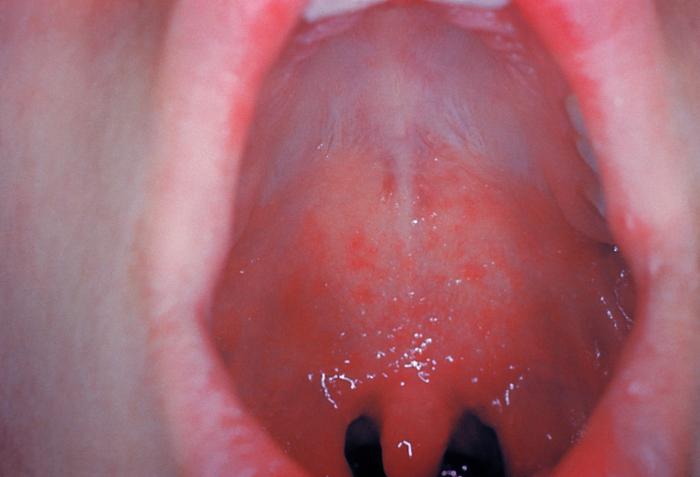Measles is a highly contagious infectious disease caused by the measles virus. Symptoms usually develop 10–12 days after exposure to an infected person and last 7–10 days. Initial symptoms typically include fever, often greater than 40 °C (104.0 °F), cough, runny nose, and inflamed eyes.
Koplik's spots (https://phil.cdc.gov/details.aspx?pid=3187)
This image depicts an intraoral view of a patient, who had presented to a clinical setting exhibiting redness and edema of the oropharynx, and small red spots, on the soft palate mucosa. A diagnosis of Koplik’s spots on the soft palate and oropharynx was made, due to pre-eruptive measles, on day-3 of the illness.
Koplik's spots are believed to be the first or an early sign of measles, rashes will appear all over the body after 3-5 days after symptoms start.
A few hours ago, the Department of Health declared an outbreak in Manila, Central Luzon, Philippines, leaving people inattention to symptoms surrounding the cases reported. Since measles is transmitted by coughing and sneezing which means airborne in origin. If a person is infected with measles, one is contagious from 4 days before and 4 days after the onset of rashes.
***images from Department of Health, Philippines
- Avoid and prevent kids from exposing them to crowded places.
- Wear a mask if needed.
- Educate people to cover their mouth when coughing or sneezing. Avoid covering your mouth with your hands as this will spread contamination when you touch things or even a touching a person. Use disposable napkin and tissue and know how to dispose of properly. When there's no available tissue or napkin, use your arm by positioning it between your nose and mouth, see image above. Also, using the collar part of your shirt your wearing, cover your nose and mouth.
- Wash hands as often as possible, proper hand washing technique and personal hygiene are important.
- Eat nutritious foods; vegetables, fruits, increase fluid intake, and add supplemental vitamins can help too.
- Monitor your temperature if you feeling sick, watch out for rashes and early sign of measles.
- Vaccination, have your babies vaccinated to prevent possible worsening of the condition on the latter part.
- Report to your doctor, have your self be recorded.






I would add to the advice to cover your mouth when you cough or sneeze to cough into your elbow. Teach kids how to cover their mouth and nose with the crook of their arm. If you cough into your hands, you just transfer germs when you touch things. You touch less with your elbow.
ReplyDeleteThanks Karen for adding that insight. :)
DeleteSimply wish to say your article is as astonishing.
ReplyDeleteThe clearness on your put up is just nice and i can think you're an expert in this subject.
Well with your permission allow me to grab your RSS feed to keep updated with
forthcoming post. Thanks one million and please carry on the enjoyable work.
This comment has been removed by a blog administrator.
ReplyDeleteOh this kind of freaks me out. I heard people are starting to get measles again, this is good info but I hope not many people start getting this on a mass level again/
ReplyDeleteThis is so scary especially when it affects kids! Just to keep them away from infected people will keep them safe!
ReplyDeleteAs Karen said ... cover your mouth when you cough or sneeze to cough into your elbow.
ReplyDeleteWhy nobody do it here in the US??? So bad.
Ugh! I had measles as a kid, so awful!
ReplyDelete